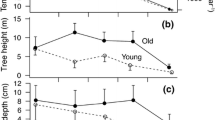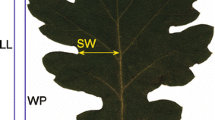Abstract
Key message
Spontaneous hybrids in natural regenerations of A. glutinosa cannot be excluded if A. incana is occurring in the neighbourhood, and has to be taken into account when restoring swamp forests.
Abstract
Swamp forests with A. glutinosa are endangered in Flanders due to habitat destruction and fragmentation, and therefore restoration is promoted. At the other hand, frequent plantations of A. incana, a non-native species in Flanders (northern part of Belgium), may facilitate spontaneous hybrids between the two species as they are interfertile. We assessed phenotypic variability of both species and putative hybrids using nine leaf, five infructescence and eight bud characters, and additionally height growth. We focussed on a field trial established with seeds collected in fifteen autochthonous A. glutinosa stands and on A. incana trees of unknown origin sampled at five locations in Flanders. We applied geometric morphometric methods, principal component analyses and mixed modelling methods. We found three individuals with intermediate morphological traits between A. glutinosa and A. incana among the eleven pedigrees in one of the two natural A. glutinosa populations where also planted A. incana was present. Their height growth was variable and only one of the three fructified, with seeds showing a normal germination success. These individuals can be hybrids with intermediate features between the parental species or they may display the natural variability of the latter with overlapping traits. Other individuals with intermediate leaf shape but less intermediate features for other leaf, bud and infructescence characters, found in the pedigrees of additional four A. glutinosa populations, may point to the relative wide natural variability for leaf shape within the parental species. Alternatively, these may concern backcrossed individuals or matro/patroclinal inheritance in hybrids. An inter-population variance study showed that several leaf characters are under a relative genetic control, underlining the importance of vegetative organs in taxonomic treatment of species complexes. The occurrence of spontaneous hybrids in natural regenerations of A. glutinosa cannot be excluded if A. incana is present in the neighbourhood, and has to be taken into account both in seed collections for the creation of autochthonous planting stock as when restoring swamp forests.









Similar content being viewed by others
References
Arnold ML (1992) Natural hybridization as an evolutionary process. Annu Rev Ecol Syst 23:237–261
Banaev EV, Bazant V (2007) Study of natural hybridisation between Alnus incana (L.) Moench. and Alnus glutinosa (L.) Gaertn. J Forest Sci 53:66–73
Bates D, Maechler M, Bolker B, Walker S (2014) lme4: linear mixed-effects models using Eigen and S4. R package version 1.1-7. http://CRAN.R-project.org/package=lme4
Bleeker W, Schmitz U, Ristow M (2007) Interspecific hybridisation between alien and native plant species in Germany and its consequences for native biodiversity. Biol Conserv 137:248–253
Bo WH, Wang Z, Xu F, Fu GF, Sui YH, Wu WM, Zhu XL, Yin DN, Yan Q, Wu RL (2014) Shape mapping: genetic mapping meets geometric morphometrics. Brief Bioinform 15:571–581
Ellstrand NC, Elam DR (1993) Population genetic consequences of small population size: implication for plant conservation. Annu Rev Ecol Syst 24:217–242
Ellstrand NC, Schierenbeck KA (2000) Hybridization as a stimulus for the evolution of invasiveness in plants? Proc Natl Acad Sci USA 97:7043–7050
Excoffier L, Foll M, Petit RJ (2009) Genetic consequences of range expansions. Annu Rev Ecol Evol Syst 40:481–501
Fu G, Bo W, Pang X, Wang Z, Chen L, Song Y, Zhang Z, Li J, Wu R (2013) Mapping shape quantitative trait loci using a radius-centroid-contour model. Heredity 110:511–519
Hegi G (1981) Illustrierte Flora von Mitteleuropa. Band III/1. Paul Parey, Berlin
Jensen RJ, Hokanson SC, Isebrands JG, Hancock JF (1993) Morphometric variation in oaks of the Apostle Islands in Wisconsin—evidence of hybridization between Quercus rubra and Q. ellipsoidalis (Fagaceae). Am J Bot 80:1358–1366
Jensen RJ, Ciofani KM, Miramontes LC (2002) Lines, outlines, and landmarks: morphometric analyses of leaves of Acer rubrum, Acer saccharinum (Aceraceae) and their hybrid. Taxon 51:475–492
Lagache L, Klein EK, Ducousso A, Petit RJ (2014) Distinct male reproductive strategies in two closely related oak species. Mol Ecol 23:4331–4343
Lambinon J, De Langhe J, Delvosalle L, Duvigneaud J (1998) Flora van België, het Groothertogdom Luxemburg, Noord-Frankrijk en de aangrenzende gebieden. Nationale Plantentuin, Meise
Lepais O, Petit RJ, Guichoux E, Lavabre JE, Alberto F, Kremer A, Gerber S (2009) Species relative abundance and direction of introgression in oaks. Mol Ecol 18:2228–2242
McVean D (1953) Alnus glutinosa (L.) Gaertn. J Ecol 41:447–466
Mejnartowicz L (1999) Evidence for long-term heterosis phenomenon in the Alnus incana × glutinosa F-1 hybrids. Silvae Genet 48:100–103
Paelinckx D, Sannen K, Goethals V, Louette G, Rutten J, Hoffmann M (2009) Gewestelijke doelstellingen voor de habitats en soorten van de Europese Habitaten Vogelrichtlijn voor Vlaanderen. Mededelingen van het Instituut voor Natuur-en Bosonderzoek INBO.M.2009.6, Brussels
Penaloza-Ramirez JM, Gonzalez-Rodriguez A, Mendoza-Cuenca L, Caron H, Kremer A, Oyama K (2010) Interspecific gene flow in a multispecies oak hybrid zone in the Sierra Tarahumara of Mexico. Ann Bot Lond 105:389–399
Petit RJ, Hampe A (2006) Some evolutionary consequences of being a tree. Annu Rev Ecol Evol Syst 37:187–214
Petit RJ, Bialozyt R, Garnier-Gere P, Hampe A (2004) Ecology and genetics of tree invasions: from recent introductions to Quaternary migrations. Forest Ecol Manag 197:117–137
Petit RJ, Hu FS, Dick CW (2008) Forests of the past: a window to future changes. Science (New York, N.Y.) 320:1450–1452
Poljak I, Idzojtic M, Sapic I, Vukelic J, Zebec M (2014) Population variability of grey (Alnus incana L. Moench) and black alder (A. glutinosa L. Gaertn.) in the Mura and Drava region according to the leaf morphology. Sumar List 138:7–17
Punyasena SW, Smith SY (2014) Bioinformatic and biometric methods in plant morphology. Appl Plant Sci 2
R_Core_Team (2013) R: a language and environment for statistical computing. R Foundation for Statistical Computing, Vienna. http://www.R-project.org/
Rhymer JM, Simberloff D (1996) Extinction by hybridization and introgression. Annu Rev Ecol Syst 27:83–109
Rohlf J (2010) tpsDig v 2.16 (computer program). Stony Brook University, New York
Sheets D (2004) CoordGen6f and PCAGen6n (computer programs). Canisius College, New York
Slice D (2013) Morpheus (computer program). Department of Scientific Computing, The Florida state University, Florida
Uri V, Tullus H, Lohmus K (2003) Nutrient allocation, accumulation and above-ground biomass in grey alder and hybrid alder plantations. Silva Fenn 37:301–311
Vander Mijnsbrugge K, Cox K, Van Slycken J (2005) Conservation approaches for autochthonous woody plants in Flanders. Silvae Genet 54:197–206
Viscosi V, Cardini A (2011) Leaf morphology, taxonomy and geometric morphometrics: a simplified protocol for beginners. PLoS ONE 6
Viscosi V, Fortini P, Slice DE, Loy A, Blasi C (2009a) Geometric morphometric analyses of leaf variation in four oak species of the subgenus Quercus (Fagaceae). Plant Biosyst 143:575–587
Viscosi V, Lepais O, Gerber S, Fortini P (2009b) Leaf morphological analyses in four European oak species (Quercus) and their hybrids: a comparison of traditional and geometric morphometric methods. Plant Biosyst 143:564–574
Viscosi V, Antonecchia G, Lepais O, Fortini P, Gerber S, Loy A (2012) Leaf shape and size differentiation in white oaks: assessment of allometric relationships among three sympatric species and their hybrids. Int J Plant Sci 173:875–884
Vit P, Lepsi M, Lepsi P (2012) There is no diploid apomict among Czech Sorbus species: a biosystematic revision of S. eximia and discovery of S. barrandienica. Preslia 84:71–96
Acknowledgments
We thank David De Lignie, Stefaan Moreels, Wim Stevens, Steven Haelterman, Yves Verhaegen, André Meersman and Karen Cox, all affiliated to the Research Institute for Nature and Forest, for seed collections, plant growth, planting of the field trial and plantation management. Furthermore we specifically thank Jaennine Moeskops, a volunteer, for several morphological measurements and observations on the herbarium.
Author information
Authors and Affiliations
Corresponding author
Ethics declarations
The author declares that she has no conflict of interest.
Additional information
Communicated by U. Luettge.
Electronic supplementary material
Below is the link to the electronic supplementary material.
Rights and permissions
About this article
Cite this article
Vander Mijnsbrugge, K. Morphological dissection of leaf, bud and infructescence traits of the interfertile native A. glutinosa and non-native A. incana in Flanders (northern part of Belgium). Trees 29, 1661–1672 (2015). https://doi.org/10.1007/s00468-015-1247-7
Received:
Revised:
Accepted:
Published:
Issue Date:
DOI: https://doi.org/10.1007/s00468-015-1247-7




